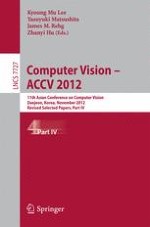The four-volume set LNCS 7724--7727 constitutes the thoroughly refereed post-conference proceedings of the 11th Asian Conference on Computer Vision, ACCV 2012, held in Daejeon, Korea, in November 2012. The total of 226 contributions presented in these volumes was carefully reviewed and selected from 869 submissions. The papers are organized in topical sections on object detection, learning and matching; object recognition; feature, representation, and recognition; segmentation, grouping, and classification; image representation; image and video retrieval and medical image analysis; face and gesture analysis and recognition; optical flow and tracking; motion, tracking, and computational photography; video analysis and action recognition; shape reconstruction and optimization; shape from X and photometry; applications of computer vision; low-level vision and applications of computer vision.
